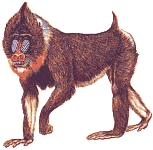


3 OCLOCK!
Chronos, Does a clock speak for itself? -Etienne Klein (page 4)
All too often we imagine that time was only measured by means of inanimate instruments like sundials, hourglasses, clepsydras, or mechanical clocks. And yet, people also used animals for the same purpose. So on one wall in Tutankhamen's tomb twenty-four baboons represent the cycle of the hours. The ancient Egyptians had indeed noticed that this animal had the peculiarity of urinating at rather regular intervals, nearly every hour. So they used its bladder for a pendulum.
But the "fold of time" really took root in the monasteries of the Western world. In contrast with the variations of secular life, monastic orders set down iron discipline, creating a rhythm that left little time for whimsical pleasure. Well before the first mechanical clocks appeared in the thirteenth century, a papal bull from seventh century Pope Sabinian, decreed that monastic bells--which generally used a clepsydra, or water clock, and a hammer--had to sound seven times every twenty-four hours. These regular chimes punctuated the day and constituted the canonic hours, marking periods consecrated to devotion: martins (night prayers), lauds (one hour before sunrise), prime (first hour of daylight), terce (midmorning), sext (noon), none (midafternoon), vespers (sunset), and compline (one hour after sunset).
~~~~~~~~~~~~~~~~~
I couldn't help share this baboon clock idea with you! And.. maybe it was even accurate!
More fun than Sabinian's though it's interesting the naming of the parts of day hum?
Love and LIGHT BEING, Teom




